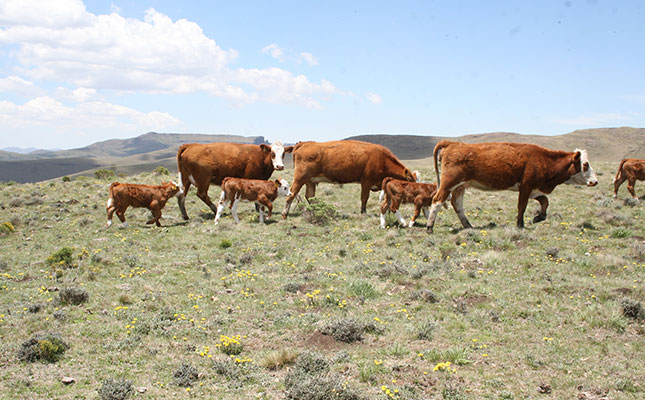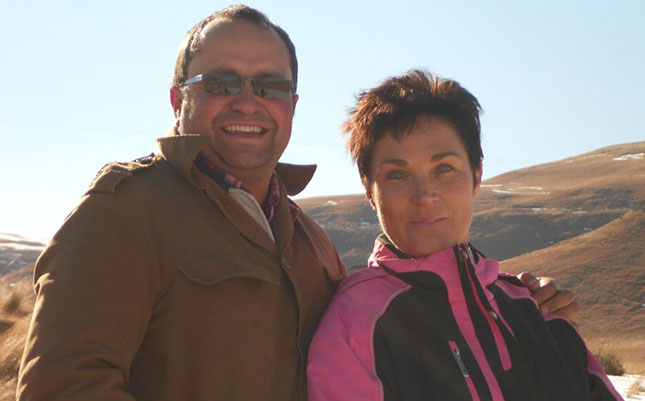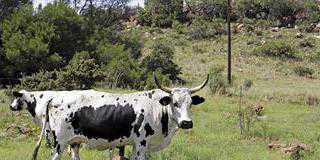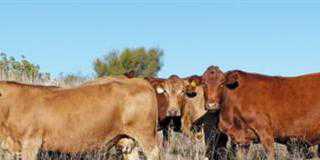
Photo: Gavin Isted
Des ‘Tjokkie’ Nel has been breeding Simmentaler cattle near Barkly East, Eastern Cape, for more than 20 years.
In 1990, after completing high school at Tweespruit Agricultural School in the Free State, he joined the South African Police Service (SAPS) in East London. After seven years here, he left to join his father Dawie on the family farm Skilderkrans in the mountainous area of Barkly East, where they ran separate Simmentaler production operations.
History of the Simmentaler breed
The Simmentaler breed dates back to the Middle Ages. According to the Simmentaler Cattle Breeders’ Society of South Africa’s website, the breed is named after the area where the cattle were first bred, the Simme River valley in Switzerland.
The society states that the Simmentaler is a descendant of the aurochs (Bos taurus primegenius), the now-extinct wild breed of cattle that was indigenous to Europe.
Nel has always favoured the breed, as it does well on the veld in mountainous regions, can walk long distances and is highly adaptable.
It also has a good temperament, which makes it easy to manage, and both bull and heifer calves are weaned at six months old at an average weight of 242kg. In addition, its hybrid vigour makes the Simmentaler ideal for crossbreeding.
The story of the Skilderkrans Stud
Dawie took over the farm from his own father in 1960, and in the beginning ran a mixed cattle-farming operation. In 1964, he bought eight Simmentaler cows and calves in Namibia, and was so impressed with the breed that he decided to start the Skilderkrans Simmentaler Stud, which was subsequently registered in 1993.

Dawie retired in 1998 and, a year later, Nel bought Skilderkrans from him. Five years after that, Dawie purchased the farm Louterbron, which is about 5km from Skilderkrans.
For many years, Dawie bought stud bulls from Donnie Thornton, a well-known Simmentaler breeder in the Eastern Cape’s Indwe district.
However, Thornton retired in 2006, and Nel now buys bulls from the Leeupoort Simmentalers stud near Rustenburg, North West, and Gulland Simmentalers near Koster, North West.
A mix of grasses
Skilderkrans covers an area of 1 460ha and is as high as 1 980m above sea level in some parts, while Louterbron is 356ha in extent and up to 1 650m above sea level. The average annual rainfall on the farms is 860mm.
The veld comprises a mixture of sweet- and sourveld, and the south-facing mountain slopes tend to be covered with unpalatable grass species such as wire grass (Elionurus muticus) and mountain wire grass (Merxmuellera disticha), interspersed with patches of turpentine grass (Cymbopogon spp.).
On the north-facing slopes more palatable grasses are found, such as red grass (Themeda triandra), small creeping foxtail (Setaria flabellata), weeping lovegrass (Eragrostis curvula) and curly leaf grass (E. chloromelas).
The veld is currently short as it is still recovering from the recent multiyear drought in the region; however, it has very good coverage. The grazing capacity is 4ha/ MLU for cattle, and 1ha/SSU for sheep.
Ouhout trees (Leucosidea sericea) cover a total of 70ha on Nel’s farms. This invasive species is a major problem in the area, says Nel. Trying to combat it by burning the veld only works for a while before the trees begin to grow back with a vengeance, and using herbicide is very expensive and time-consuming.
Nel plants oats and rye for winter feeding. The possibilities for irrigation are good, as some of the nearby streams never dry up, despite the drought; however, he has not yet found it necessary to irrigate.
Breeding and selection policies
Nel’s cow herd is just over 200-head strong, and he normally achieves a 95% calving rate, and 93% weaning rate. His animals are bred only via natural means, and he has never considered the use of artificial insemination. His preferred bull-to-cow ratio is 1:20, as this assures him of a better conception rate.
During breeding season, the bulls are kept with the cows for 85 to 90 days. The calving period normally runs for about three months from mid-September.
Nel never uses a bull whose dam has an inter-calving period of more than 400 days. He selects medium-frame cows of between 420kg and 450kg, and bulls that sire calves that weigh 38kg to 43kg at birth.
If a bull sires small heifers (30kg to 34kg), the latter are likely to go on to experience calving difficulties. Nel culls all cows that don’t calve easily, as well as those that don’t produce enough milk or raise their calves easily on the veld. But this usually amounts to fewer than 2% of his herd.
He uses the best linear unbiased prediction (BLUP) method in conjunction with the HerdMaster herd-management and performance-recording software. However, he stresses the importance of ensuring that the BLUP figures correlate with the results of hand-and-eye judging.
According to him, this is particularly important when buying bulls. It is also crucial for a stud to have good-quality cows for breeding. Nel selects only bulls that were weaned on the veld at six months old and weighing 240kg to 280kg. Stud selection is normally done when the young bulls are 15 to 16 months old.
Feeding and licks
Nel gives his cattle a protein lick in winter and a phosphate lick in summer. Commercial male weaners are sold in April, and both commercial and stud heifers are separated from the young bull calves and put on good veld with a protein lick.
The bull calves receive a protein lick and are put onto rested veld until November when they’re about one year old. They then receive Supermol feed until the following May, when they are 18 months old. After this, they are given a bull ration in preparation for the bull sales, which start in September.
Dosing and sales
Nel uses injectable vaccines against both internal and external parasites, and administers these in May and September each year. The stud and sale bulls are tested by a local veterinarian for various diseases, including bovine trichomoniasis and brucellosis, in July and August.
Nel never sends his cattle to shows, as he prefers to attend bull sales only. He has taken animals to the Barkly East Bull Sale for the past 11 years, and the Kuruman Ram & Bull Sale for the past six.
Strong relationships
Nel places great value on a good workforce, as he sees his staff as assets. He strives to forge strong relationships with his workers, and they attend training and upliftment programmes on a regular basis to keep them motivated. His advice to young breeders is to farm the animals they love.
“Be honest, work hard, and buy animals from reputable breeders who are prepared to guide you,” he adds.
Phone Tjokkie Nel on 079 568 0947, or email him at [email protected].











